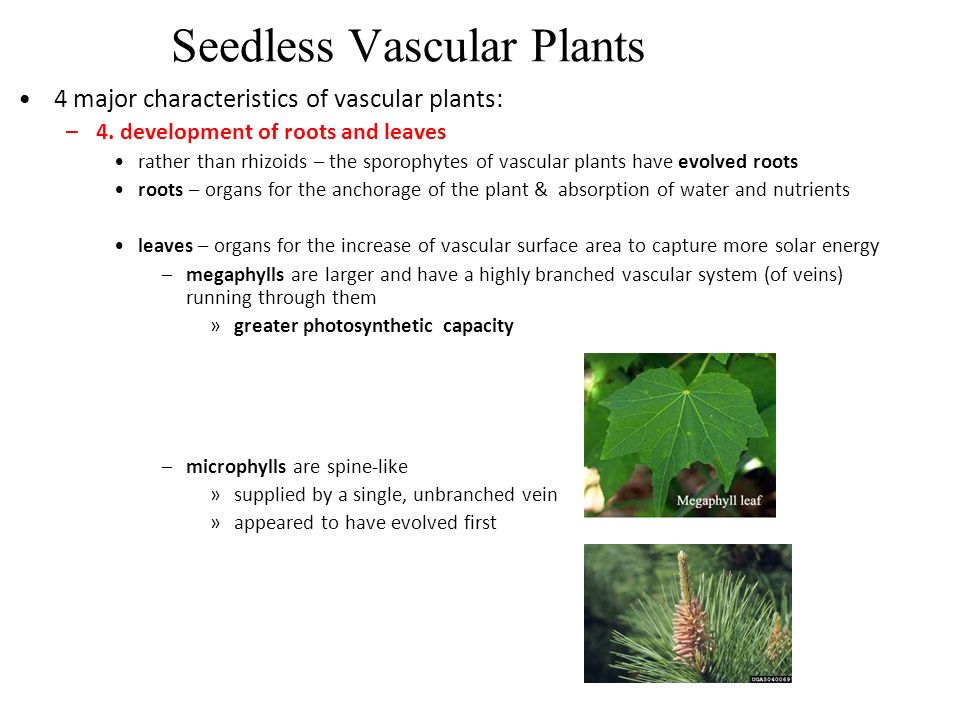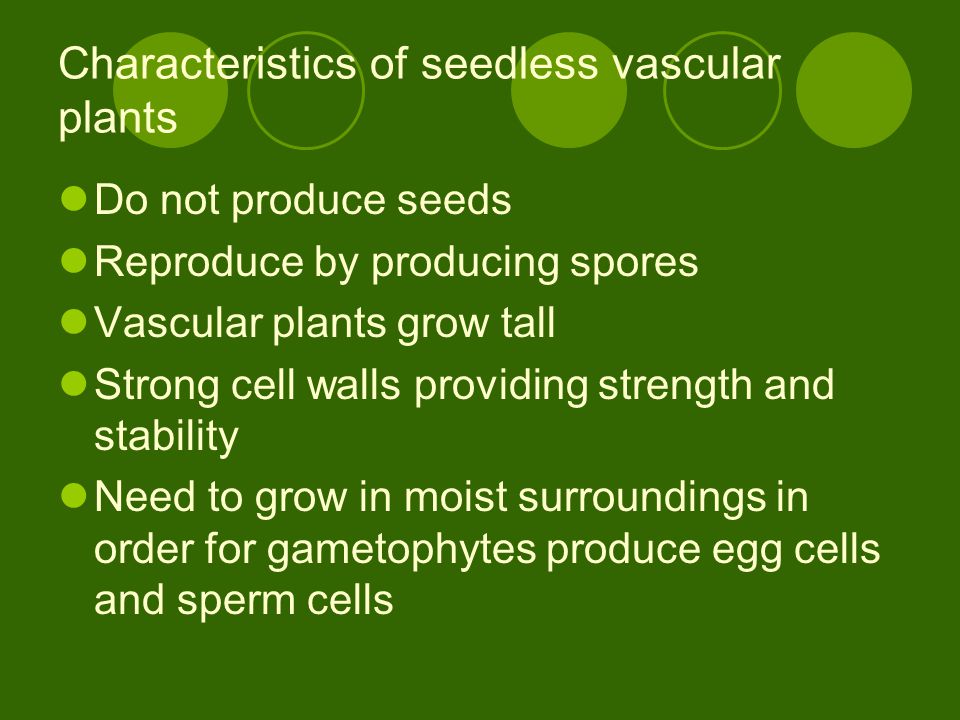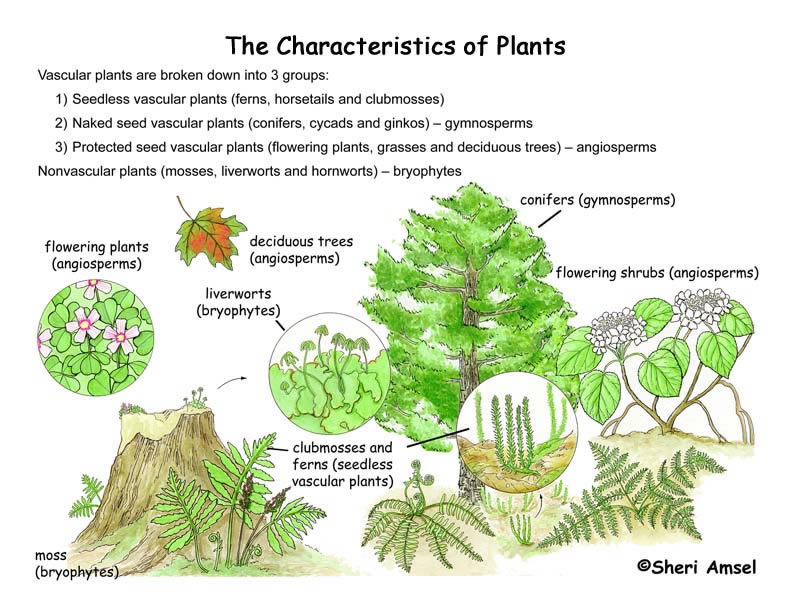Characteristics Of Seedless Vascular Plants
During the other phase of. The Lycopodiophyta club mosses Monilophyta horsetails Psilotopsida whisk ferns and Polypodiopsida true ferns.

Seedless Vascular Plants Ppt Video Online Download Source: slideplayer.com
These plants have motile sperm and are still dependent on water for reproduction.

Characteristics of seedless vascular plants. In a few cases the leaves and roots arise from underground stems called rhizomes which also store food. Non-vascular plants or bryophytes include the most primitive forms of land vegetationThese plants lack the vascular tissue system needed for transporting water and nutrients. Ferns form large leaves and branching roots.
Identify phases in the life cycles of seedless vascular plants. Most seedless vascular plants grow on land in moist areas. In contrast whisk ferns the psilophytes lack both roots and leaves which were probably lost by evolutionary reduction.
Water is still required for fertilization of seedless vascular plants and most favor a moist environment. In seedless vascular plants the sporophyte became the dominant phase of the lifecycle. Non-vascular plants typically appear as small green mats of vegetation.
The spores of seedless plants are surrounded by thick cell walls containing a tough polymer known as sporopollenin. Seedless vascular plants fall into four main groups. They possess stem leaves and roots in some of them they each parts may not be distinguishable.
Like all plants seedless vascular plants undergo an alternation of multicellular generations. In seedless vascular plants the sporophyte became the dominant phase of the life cycle. Botanists group ferns club mosses and horsetails together as being seedless vascular plants.
The main characteristic features of the seedless vascular plants are. Ferns are considered the most advanced seedless vascular plants and display characteristics commonly observed in seed plants. Modern-day seedless tracheophytes include club mosses horsetails ferns and whisk ferns.
Characteristics of Seedless Vascular Plants The division Seedless vascular plants is a paraphyletic grouping that includes two phyla of plants. Sporophytes develop complex tissues including lignified vascular tissue true roots stems and leaves. Sporophytes are branched producing many sporangia.
In seedless vascular plants such as ferns and horsetails the plants reproduce using haploid unicellular spores instead of seeds. Seedless vascular plants have true leaves and roots and they produce sporophylls in their sporophyte stage. Ability to transport food and water allow plant to get bigger ability to synthesize lignin is incorporated in walls of xylem cells allow plant to get taller Click again to see term 171.
No seed formation occurs in these types of plants. Ii Cryptogams do not form flowers and fruits as. Classification of Kingdom Plantae 1 Subkingdom Cryptogamae i Cryptogams consist of seedless plants and plant-like organisms.
Sporopollenin is unusually resistant to chemical and biological degradation. The spores are very lightweight unlike many seeds which allows for their easy dispersion in the wind and for the plants to spread to new habitats. Seedless vascular plants are characterized by the presence of true roots stems and leaves though sometimes these parts cannot be clearly distinguished from each other.
Gametophytes are reduced and thalloid. This complex substance is characterized by long chains of organic molecules related to fatty acids and carotenoids. Water is still required as a medium of sperm transport during the fertilization of seedless vascular plants and most favor a moist environment.
A vascular system allows the movement of water and nutrients through the plants body and instead of reproducing with seeds they reproduce asexually with spores. Characteristics of Seedless Vascular Plants. Unlike angiosperms non-vascular plants do not produce flowers fruit or seedsThey also lack true leaves roots and stems.
Hence the yellow color of most pollen. Modern-day seedless tracheophytes include club mosses horsetails ferns and whisk ferns. The first sub-kingdoms consist of plants that are non-vascular and seedless plants known as Cryptogamae.
They reproduce through spores. The second sub-kingdoms are consisting of vascular and seed-bearing plants known as Phanerogamae.

Pin On Seedless Vascular Plants Source: www.pinterest.com

What Are Examples Of Vascular Plants Source: theofy.world

General Character Of Seedless Vascular Plants Source: theofy.world

Different Types Of Seedless Vascular Plants Part 2 Loving Biology Source: gotalktogetherdotcom.wordpress.com

Science By Beth Bridges Source: www.haikudeck.com

Vascular Plants Vs Nonvascular Plants Source: www.exploringnature.org
